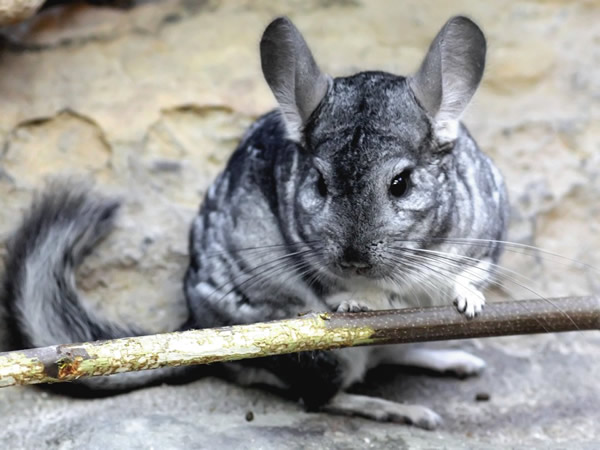 |
| Short-tailed Chinchilla |
The short-tailed chinchilla is a nocturnal (active at night) rodent with soft fur, large ears, and a bushy tail. It is one of two species of chinchilla—the other is the long-tailed chinchilla (Chinchilla langiera).
An average chinchilla has a head and body length between 9 and 15 inches (23 and 38 centimeters) and a tail length between 3 and 6 inches (7.5 and 15 centimeters).
Female chinchillas weigh up to 28 ounces (794 grams), while the smaller males weigh up to 18 ounces (510 grams). A chinchilla’s silky fur is mostly gray in color. The animal’s hind legs are much larger than its front legs, making it an agile jumper.
  |
A chinchilla’s diet includes leaves, seeds, fruits, and other vegetation. While eating, it often stands erect and holds the food with its forepaws. A female chinchilla may give birth to up to six infants at a time.
Habitat and current distribution
Short–tailed chinchillas prefer to live in the mountainous regions of Argentina, Bolivia, Chile, and Peru at elevations over 6,560 feet (2,000 meters). They live among crevices and rocks in barren areas covered with dense shrubs and grasses. The number of short-tailed chinchillas in the wild is unknown, but centuries of hunting has severely reduced their population.
History and conservation measures
Humans have prized chinchilla fur since the days of the Incas, native Quechuan people of Peru who established an empire in South America in the fifteenth century. Between 1895 and 1900, 1,680,000 chinchilla skins were exported from the country of Chile alone. Coats made from the animal’s soft fur have sold for over $100,000. Since the 1920s, millions of chinchillas have been raised on farms for use in the fur industry.
Before laws were passed protecting wild chinchillas, hunters almost made the animals extinct. Reserves have been established to provide wild short-tailed chinchillas with a protected habitat, but illegal hunting still threatens their survival.
